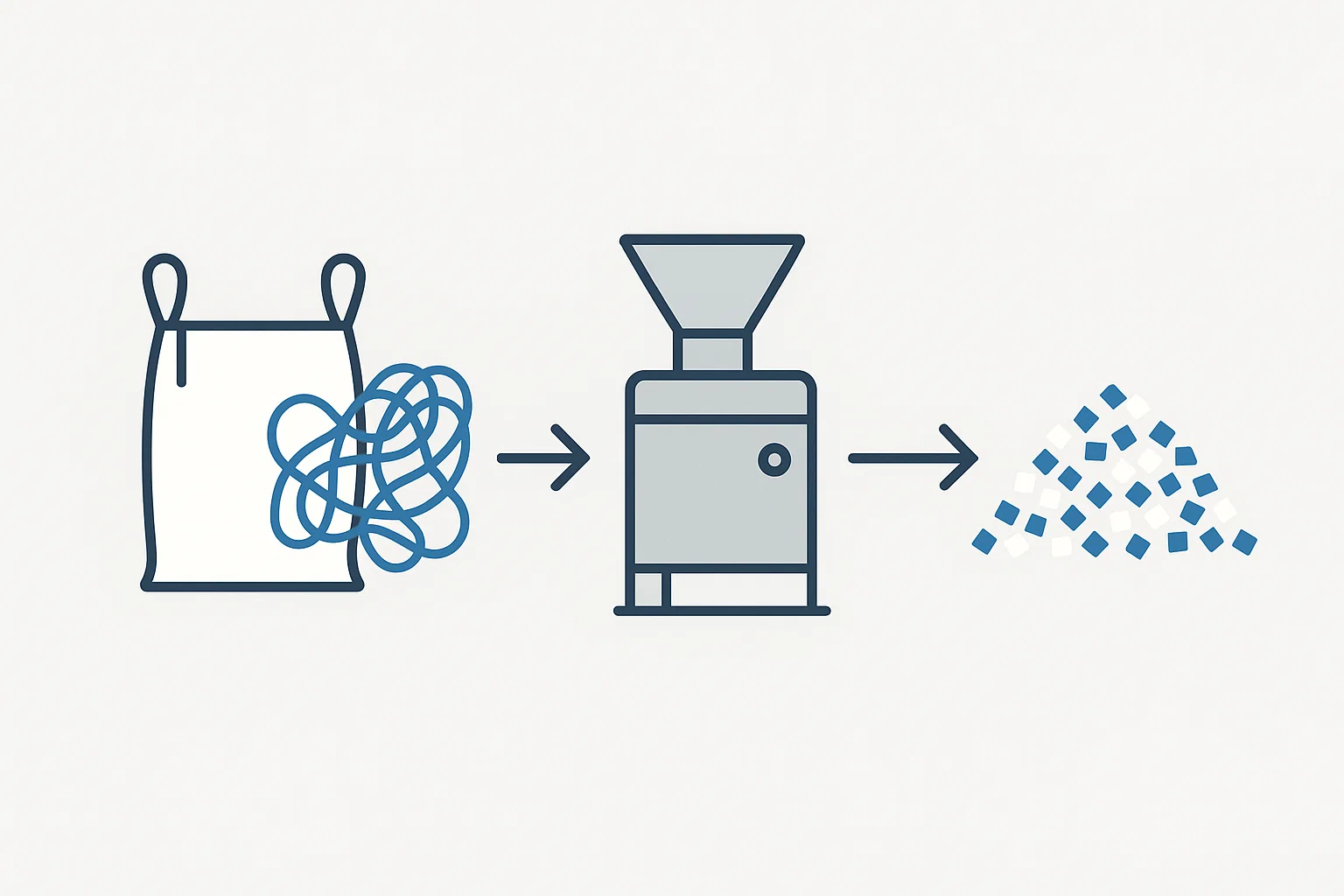In the world of industrial recycling, few materials present as unique a challenge as Flexible Intermediate Bulk Containers (FIBCs), or tonne bags, and end-of-life fishing nets. While both represent a significant stream of valuable polymers like polypropylene (PP) and nylon, their tough, flexible, and fibrous nature can bring standard recycling machinery to a grinding halt.
Successfully turning this challenging waste into a profitable resource isn’t about brute force; it’s about precision engineering and a deep understanding of the technical nuances involved. For manufacturers and recycling professionals looking to invest in this sector, choosing the right equipment is paramount to ensuring efficiency, profitability, and operational reliability.
At Energycle Machine, we have extensive experience in designing and implementing solutions for these demanding applications. This guide distils our expertise, exploring the critical technical details you must consider to effectively shred FIBC bags and fishing nets.
Understanding the Materials: A Tale of Two Tough Plastics
Before diving into the machinery, it’s crucial to understand why these materials are so difficult to process. While both are flexible, they have distinct properties that demand a tailored approach.
FIBCs (Tonne Bags / Jumbo Bags):
- Material: Primarily woven polypropylene (PP), a durable and resilient polymer.
- Construcție: The woven fabric construction gives them incredible tensile strength, designed to hold over a tonne of material without tearing.
- Provocări:
- High Strength: Resists cutting and can stretch and wrap around machinery components.
- Abrasive Contamination: Often contain residual sand, gravel, cement, or other abrasive materials that cause rapid wear on shredder blades.
- Bulk Density: Can be fed in dense, compressed bales, requiring a powerful and intelligently controlled feeding system.
Fishing Nets:
- Material: Typically made from high-strength polymers like Nylon (PA6, PA6.6), High-Density Polyethylene (HDPE), or Polypropylene (PP).
- Construcție: Comprised of long, intertwined, and often knotted filaments.
- Provocări:
- Extreme Entanglement: This is the primary challenge. The long, strong fibres have an extreme tendency to wrap around any rotating component, creating a “bird’s nest” that can seize a shredder’s rotor in seconds.
- Rezistență ridicată la tracțiune: Nylon, in particular, is incredibly tough and elastic, making it difficult to achieve a clean cut.
- Marine Contamination: Often fouled with marine growth, salt, sand, and sometimes metal components (weights, hooks), which are both abrasive and corrosive.
| Caracteristică | FIBC (Tonne) Bags | Fishing Nets |
|---|---|---|
| Primary Polymer | Polipropilenă (PP) | Nylon (PA), PE, PP |
| Key Challenge | High Strength & Abrasiveness | Extreme Entanglement & Elasticity |
| Common Form | Baled, compressed sheets | Loose, tangled bundles |
| Contaminanți | Sand, gravel, product residue | Salt, sand, organic matter, metal |
Why Standard Shredders Fail: The Common Pitfalls
Attempting to process these materials with a generic or improperly configured shredder often leads to a series of costly operational failures:
- Material Wrapping (Entanglement): The most common failure point. Flexible materials wrap tightly around the rotor shaft, between the blades and the main body. This requires extensive, hazardous, and time-consuming manual cleaning, resulting in significant downtime.
- Randament redus: A machine not designed for these materials will struggle to grab and pull them into the cutting chamber effectively. The material may “float” on top of the rotor or clog the feeding hopper.
- Excessive Blade Wear: Abrasive contaminants like sand rapidly dull the cutting edges. Dull blades tear rather than cut, worsening entanglement and increasing energy consumption.
- Inconsistent Particle Size: Poor cutting action produces a mix of oversized pieces and fine dust, which is problematic for downstream processes like washing and extrusion.
To overcome these issues, a specialised machine is required. For these applications, a robust tocător cu un singur arbore is often the most effective starting point, but only when it incorporates specific technical modifications.
The Solution: Key Technical Specifications for an Optimised Shredder
Success lies in the details. A high-performance shredder for FIBCs and fishing nets is a system where every component is designed to work in harmony to prevent entanglement and ensure a clean, efficient cut.
1. Rotor Design: The Anti-Entanglement Core
The rotor is the heart of the shredder. Its design is the single most important factor in processing fibrous materials.
- Segmented, ‘V-Cut’ or ‘C-Cut’ Rotors: Unlike a standard flat rotor, specialised rotors feature a ‘V’ or concave (‘C’) profile. This design actively funnels material towards the centre of the cutters, promoting a slicing action rather than a tearing one. The segmented nature of the rotor body minimises flat surfaces where material can begin to wrap.
- Low Rotational Speed (RPM) & High Torque: This is counter-intuitive for some, but crucial. A slower rotor speed (typically 60-90 RPM) combined with a high-torque gearbox provides the immense turning force needed to power through tough, elastic materials without gaining the momentum that encourages wrapping. It’s about controlled power, not speed.
2. Cutting Technology: Blades and Counter-Blades
The cutters perform the physical work, and their geometry and material are critical.
- Concave, Hooked Blades: The individual cutter blades should be concave or hooked. This geometry allows them to actively grab, pierce, and pull the flexible material against the counter-blades for a decisive scissor-like cut. Standard square blades tend to push and stretch the material.
- Hard-Faced & Specialised Steel: To combat abrasion from sand and grit, blades must be made from high-quality, wear-resistant tool steel (e.g., D2, Chipper) and should be hard-faced. This weld-on layer of extremely hard material on the cutting edge can increase blade lifespan by 3-5 times, significantly reducing operational costs.
- Optimised Blade Clearance: The gap between the rotating blades and the stationary counter-blades must be precisely set. Too wide, and materials will squeeze through without being cut, leading to long strips and entanglement. Too tight, and friction and wear increase. An Energycle Machine specialist can configure this clearance based on the specific material.
3. Intelligent Feeding System: The Hydraulic Pusher Ram
How material is presented to the rotor is just as important as the cutting action itself.
- Load-Sensing Control: A sophisticated hydraulic pusher ram is essential. It should be governed by a load-sensing system that monitors the amperage draw of the main rotor motor. When the motor load spikes (indicating a tough section of material), the ram automatically retracts slightly, relieving pressure and allowing the rotor to clear the material before continuing its push. This prevents overloading, stalls, and jamming.
- Programmed Ram Cycles: For extremely difficult materials, the ram can be programmed with specific “nibbling” cycles, pushing forward in short, controlled strokes to feed the material into the cutters gradually.
4. Screen Selection: Defining the Output
The perforated screen underneath the rotor determines the final size of the shredded material.
- Hole Size vs. Throughput: A larger screen hole diameter (e.g., 80-100mm) will yield higher throughput but a larger particle size. A smaller hole (e.g., 40-50mm) produces a finer, more uniform shred, ideal for washing lines, but will reduce the overall throughput.
- Anti-Blinding Design: For very fine or slightly sticky materials, screens can become “blinded” or clogged. Specialised screen designs and ensuring a sharp cutting action help to minimise this.
A Systemic Approach: The Energycle Machine Advantage
At Energycle Machine, we understand that a shredder is rarely a standalone unit. It’s the cornerstone of a complete recycling line. Our approach focuses on seamless integration for maximum efficiency.
1. Input: Baled FIBCs or loose, tangled fishing nets are loaded onto a conveyor.
2. Pre-Treatment (Optional but Recommended):
* Bale Breaker: For highly compressed FIBC bales.
* Initial Size Reduction: A pre-shredder or guillotine can cut large bundles of nets into more manageable sections.
* Contaminant Removal: Sand removal systems or manual sorting to remove large metal pieces.
3. The Core Process: Energycle Machine Single-Shaft Shredder:
* The material is fed into the shredder, which is specifically configured with the rotor, blades, and control systems described above. It produces a uniform, controlled particle size (e.g., <60mm).
4. Downstream Processing:
* Conveying: The shredded material is transported to the next stage.
* Washing & Separation: A friction washer and float-sink tank remove dirt, salt, and other contaminants.
* Uscare: A mechanical or thermal dryer removes moisture.
* Pelletising/Extrusion: The clean, dry flake is compounded and extruded into high-quality recycled pellets, ready for manufacturing new products.
By optimising the shredder for the material, we ensure that the downstream equipment receives a consistent, high-quality feedstock, improving the efficiency of the entire plant.
Întrebări frecvente (FAQ)
1. Can I shred both FIBC bags and fishing nets with the same machine?
Yes, it is possible. However, the optimal configuration for each may differ slightly. An Energycle Machine shredder can be designed with versatile settings and easily swappable screens to handle both materials effectively. The key is to discuss your full range of feedstock with our engineers during the specification process.
2. How important is removing contaminants like sand and metal before shredding?
It is critically important. While our shredders are built with robust, wear-resistant components, pre-sorting to remove large metal objects prevents catastrophic damage. Removing excess sand and grit drastically extends the life of the blades, reducing your cost per tonne and maintaining a high-quality cut.
3. How do I determine the right size shredder and motor power for my facility’s needs?
This depends on three factors: the type of material you are processing, your required hourly throughput (in kg or tonnes), and the desired output particle size. Our technical team works with you to analyse these requirements and recommends a machine that provides reliable performance without being oversized and inefficient.
Conclusion: Turning a Challenge into an Opportunity
Shredding FIBC bags and fishing nets is a technically demanding process, but it is far from impossible. Success hinges on moving beyond generic equipment and investing in a solution that is engineered specifically for the unique challenges of tough, flexible materials.
By focusing on the critical technical details—an anti-entanglement rotor, specialised cutting geometry, intelligent feed control, and robust construction—a tocător cu un singur arbore can be transformed into a highly efficient and profitable processing powerhouse. This specialised approach, championed by Energycle Machine, minimises downtime, lowers operational costs, and unlocks the true value hidden within these challenging waste streams.
Ready to transform your most difficult plastic waste into a valuable asset?
Don’t let entanglement and downtime dictate your bottom line. Contact the experts at Energycle Machine today for a personalised consultation on your specific application.



